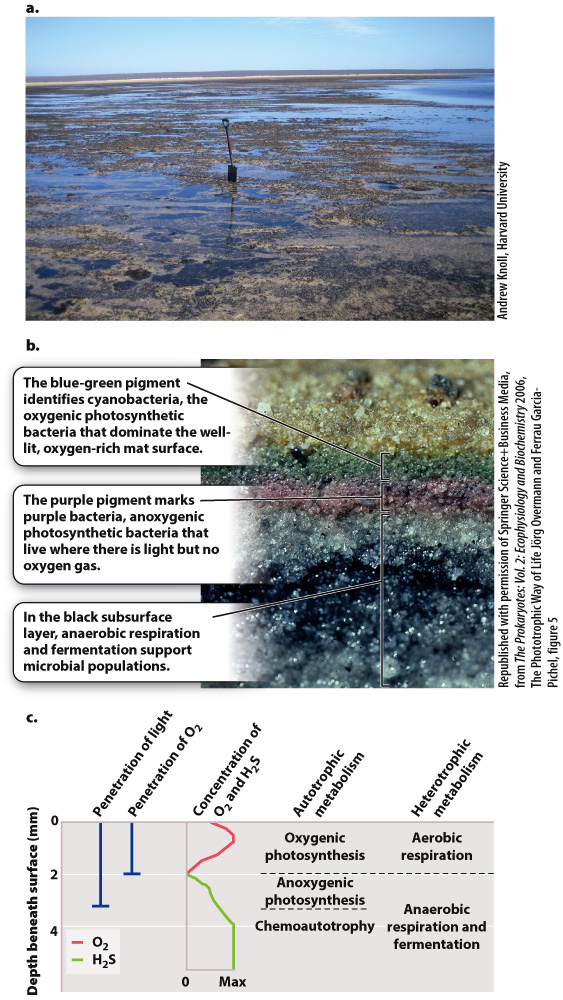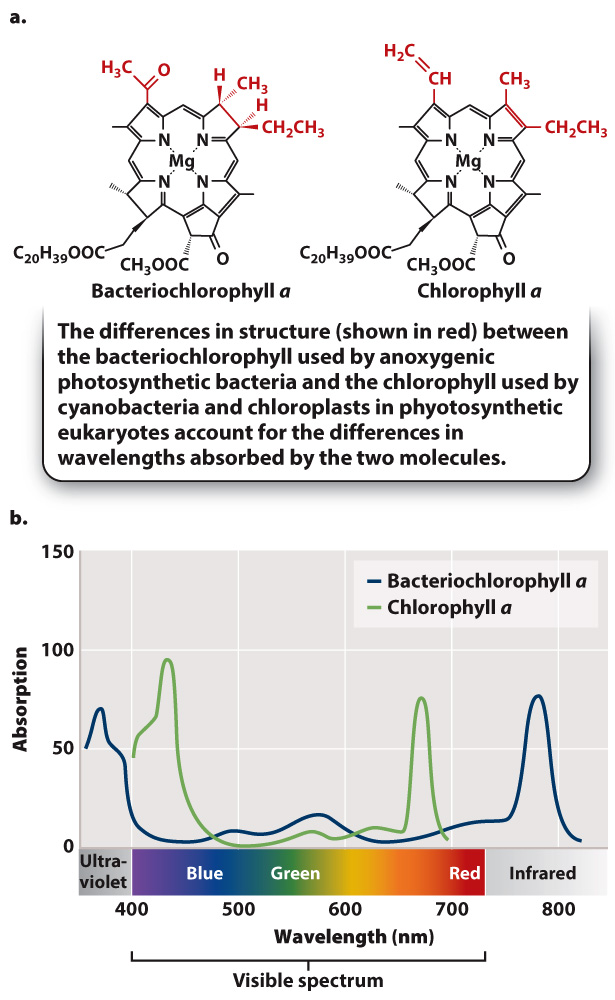Many photosynthetic bacteria do not produce oxygen.
In saline bays along the west coast of Australia and many other low-lying tropical coastlines, carpets of deep blue-green cover tidal flats along restricted lagoons where high salinity and periodic exposure limit colonization by algae and animals (Fig. 26.7). Called microbial mats, the carpets shown in Fig. 26.7a are densely packed communities of (mostly) bacteria and archaeons that have a predictable structure based on the depths to which light and oxygen penetrate into the mat (Figs. 26.7b and 26.7c). In the upper layer, where both light and oxygen are present, the mat is dominated by cyanobacteria, bacteria that photosynthesize like plants and algae, using water as an electron donor and releasing oxygen gas (the blue-green layer in Fig. 26.7b). It is the photosynthetic pigments in the cyanobacteria that impart the blue-green color to microbial mats. The cyanobacteria share this layer with heterotrophic bacteria, which get their carbon from preformed organic molecules. Both cyanobacteria and the heterotrophic bacteria respire aerobically, using O2 to oxidize organic molecules to CO2. Thus, at the mat surface, prokaryotic microorganisms carry out a biological carbon cycle much like the one outlined for plants and animals in Chapter 25.

FIG. 26.7 Microbial mats. Mats, like the example in (a) from Western Australia, cover tidal flats and lagoons where salinity or other environmental factors inhibit animals and seaweeds. As shown by the example from (b) Cape Cod, microbial mats have sharp vertical gradients of light, oxygen, and other chemical compounds, and so support nearly all the energy metabolisms found in (c) the expanded carbon cycle.
University; b. Republished with permission of Springer Science+Business Media, from The Prokaryotes: Vol. 2: Ecophysiology and Biochemistry 2006, The Phototrophic Way of Life Jörg Overmann and Ferrau Garcia-Pichel, figure 5.
What happens beneath the mat surface is a different story. Note in Fig. 26.7b that a distinct purple layer lies beneath the blue-green mat surface. Light penetrates into this layer, but oxygen does not because aerobic respiration rapidly consumes O2 within the mat (Fig. 26.7c). What organisms live where light is present and oxygen absent?
Like the cyanobacteria in the surface zone, these bacteria are photosynthetic, but they do not use water as an electron donor and so do not generate oxygen gas. Called anoxygenic because they do not produce oxygen, these photosynthetic bacteria use electron donors such as hydrogen sulfide (H2S), hydrogen gas (H2), ferrous iron (Fe2+), and even the arsenic compound arsenite (AsO33–). Where O2 is present, these compounds oxidize quickly and so are not available for photosynthesis. Therefore, microorganisms that conduct anoxygenic photosynthesis are restricted to sunlit habitats where O2 is absent.
The purple color in the mat layer comes from bacteriochlorophyll, a light-harvesting pigment closely related to the chlorophyll found in plants, algae, and cyanobacteria (Fig. 26.8a). Because of its chemical structure, bacteriochlorophyll absorbs most strongly at wavelengths different from those absorbed by the cyanobacteria above them in the mat (Fig. 26.8b).

FIG. 26.8 Structures and absorption spectra of bacteriochlorophyll a and chlorophyll a. Note that bacteria absorb wavelengths of light that are outside the visible spectrum.
Anoxygenic photosynthesis differs from oxygenic photosynthesis in another important way: It employs only a single photosystem. As discussed in Chapter 8, a single photosystem cannot capture enough energy to oxidize water and then use those electrons to reduce CO2. Therefore, oxygenic photosynthesis has two photosystems in series. With only a single photosystem, bacteria that carry out anoxygenic photosynthesis use electron donors that donate their electrons more easily than water.

